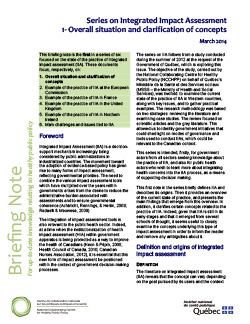Series on Integrated Impact Assessment (IIA): 1-Overall situation and clarification of concepts
This briefing note is the first in a series of six focused on the state of the practice of integrated impact assessment (IIA). These documents focus, respectively, on:
- Overall situation and clarification of concepts
- Example of the practice of IIA at the European Commission
- Example of the practice of IIA in France
- Example of the practice of IIA in the United Kingdom
- Example of the practice of IIA in Northern Ireland
- Main challenges and issues tied to IIA
Integrated Impact Assessment (IIA) is a decision-support mechanism increasingly being considered by public administrations in industrialized countries. The movement toward the adoption of evidence-based policy has given rise to many forms of impact assessment, reflecting governmental priorities. The need to combine the various impact assessment tools which have multiplied over the years within governments arises from the desire to reduce the administrative burden associated with assessments and to ensure governmental coherence (Achtnicht, Rennings, & Hertin, 2009; Radaelli & Meuwese, 2009).
The integration of impact assessment tools is also relevant to the public health sector. Indeed, at a time when the institutionalization of health impact assessment (HIA) within government apparatus is being promoted as a way to improve the health of Canadians (Keon & Pépin, 2008; Health Council of Canada, 2010; Canadian Nurses Association, 2012), it is essential that this new form of impact assessment be positioned within the context of government decision-making processes.
The series on IIA follows from a study conducted during the summer of 2012 at the request of the Government of Québec, which is exploring this issue. The objective of the study, carried out by the National Collaborating Centre for Healthy Public Policy (NCCHPP) on behalf of Québec’s Ministère de la Santé et des Services sociaux (MSSS – the Ministry of Health and Social Services), was twofold: to examine the current state of the practice of IIA in Western countries, along with key issues, and to gather practical examples. The research methodology was based on two strategies: reviewing the literature and examining case studies. The review focused on scientific articles and the grey literature. This allowed us to identify government initiatives that could shed light on modes of governance and tools used to conduct IIAs, which could be relevant to the Canadian context.
This series is intended, firstly, for government actors from all sectors seeking knowledge about the practice of IIA, and also for public health actors who wish to learn more about integrating health concerns into the IIA process, as a means of supporting decision making.
This first note in the series briefly defines IIA and describes its origins. Then it provides an overview of the current state of practice, and presents the main findings that emerge from this overview. In addition, it clarifies certain concepts related to the practice of IIA. Indeed, given that IIA is still in its early stages and that it emerged from several schools of thought, it seems useful to closely examine the concepts underlying this type of impact assessment in order to inform the reader and remove any ambiguities about it.


